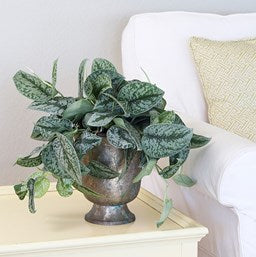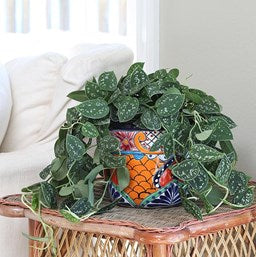Scindapsus (Scindapsus spp.)
Scindapsus Plant Features
Scindapsus are a group of are popular houseplants that are closely related to pothos and philodendron. Like their relatives, they can be grown as climbing vines up a totem or trellis. Or, you can treat them as trailing houseplants from hanging baskets.Most common varieties have green, heart-shaped leaves, and many bear a silvery overlay or variegation. They're relatively versatile indoors as they tolerate low light fairly well, but do best in bright spots. This metallic sheen and their relationship to pothos (Epipremnum) have earned many common names like silver pothos or satin pothos.
No matter what you call them, they're elegant plants native to the tropics of Southeast Asia. Over time, with good care, they can climb/trail 6 feet or more. When grown vertically, the leaves will grow larger and more dramatic.
Scindapsus Growing Instructions
Scindapsus Light NeedsThese tropical houseplants grow best -- and fastest -- when sited in a spot that has medium to bright, indirect light. Not sure exactly what that means? A good general guide is that the plant should cast a medium to strong shadow much of the day. Examples of this type of light include near a large east- or west-facing window.
Tip: If you don't have enough natural light, you can augment or replace with artificial light. Scindapsus grow just as well under lights as they do with indirect sun!
Scindapsus Water Needs
Like many other plants in the aroid family (including monstera, pothos, philodendron, and aglaonema), it's important not to overwater this houseplant. Allow the top couple of inches of the potting mix to dry to the touch before watering again (if it's in a small pot). In larger pots, allow the top third to half of the potting mix dry.
If you're not sure whether your Scindapsus needs water, it's usually better to wait.
Scindapsus Humidity Needs
As you might guess from a tropical plant like this, most common Scindapsus varieties like average to high humidity. If the air gets too arid, you may see leaf edges go brown and dry. You can boost humidity levels by growing your Scindapsus with other houseplants or setting a small humidifier nearby.
Scindapsus Fertilizer Needs
You can -- if you wish -- fertilize your Scindapsus. Doing so will encourage more and faster growth. Scindapsus really isn't fussy about what kind of fertilizer you use, as long as you use a product formulated for use on houseplants. Follow the directions on the fertilizer packaging for application rate and frequency. You can use less fertilizer than it recommends, but never use more.
Tip: The best time in most areas to fertilize Scindapsus is the warm months of spring and summer when the days are long and the plant is putting more energy into active growth.
Pruning Scindapsus
Pruning your Scindapsus may not be necessary, although you can trim it if it starts to grow out of bounds. To do this, simply pinch off the top couple of inches from a stem. This will encourage side shoots to grow, giving you a fuller plant.
-
Water
Medium water needs
-
Light
Indoors: High light
Indoors: Medium light
-
Colors
Green
Silver
Variegated
-
Special Features
Colorful foliage
Purifies the air
Complement your Scindapsus
Little Swiss MonsteraContrast Little Swiss monstera's lush green leaves with Scindapsus' silvery tones.
Birkin Philodendron
Brighten corners of your houseplant display by mixing Scindapsus with white-variegated houseplants like Birkin Philodendron.
Cane Begonia
Create a dramatic houseplant display by mixing and matching cane begonias with different varieties of Scindapsus.




